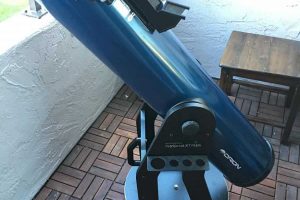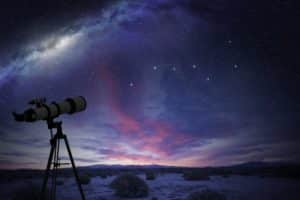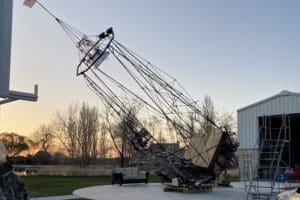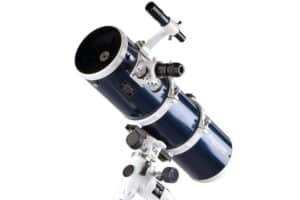What is the best telescope for beginners? And how do you pick the right telescope for you? This two-part guide provides everything you need to get started with beginner telescopes.
See also:
Anyone can enjoy astronomy and stargazing! Beginner astronomers, families and experienced stargazers alike can share in the wonders of the night sky. It’s truly a life-long hobby. Whether you love the Moon and planets or the splendors of star clusters and galaxies, there’s a telescope out there for everyone.
So how do you get started? Below, you will find:
- First, a list with our opinion of the best telescope for beginners based on current offerings and price ranges. Picking your first beginner telescope from here gets you off on the right foot.
- Second, to help narrow down the choice, an in-depth telescope buyer’s guide for 2022 on what to consider when buying your first telescope.
(Before we begin, please note that product pricing, price categories and availability are accurate as of the date of this post, but are subject to change. This post represents the author’s opinion, based on research and experience, of the “best” or “top” telescopes in this category; the opinions of others may vary. If you have other questions, let us know through our ‘contact us’ page and we will try to get you more information.)
Part 1 | What is the Best Telescope for Beginners?
With a multitude of beginner telescopes to choose from, any reliable list of the best telescope for beginners will balance a variety of factors, including image quality, price range, ease-of-use and more. We’ve set out our recommended picks below and identified what we view as the best telescope for beginners in several different buyer profiles. While specific rankings are imprecise, we are confident that each entry on this list offers a high quality telescope worth consideration by any initiate amateur astronomer.
1. Zhumell Z130 Portable Altazimuth Reflector (Tabletop Dobsonian) – All-Around Best Telescope for Beginners
In our view, the Zhumell Z130 reflector offers our top all-around pick for the best telescope for beginners. It’s a fantastic value offering the high image quality of a Dobsonian in a compact package at a great price point.
Scorecard – Zhumell Z130 Reflector Telescope
| Category | Our Verdict | Why? |
|---|---|---|
| Skill Level | Beginner | Suitable for beginners |
| Quality | 4 out of 5 | Great component quality |
| Ease of Use | 5 out of 5 | Easy to use tabletop design; requires collimation |
| Power & Clarity | 4 out of 5 | Bright images with 5" primary mirror |
| Control | 4 out of 5 | Easy to point and move to your target |
| Portability | 5 out of 5 | Super compact, easy to setup and move |
| Accessories | 4 out of 5 | Everything needed to get started, includes 2 eyepieces |
| Overall Value | 5 out of 5 | Superb value |
Why We Like It
For starters, it will usually cost less than other scopes of a similar size. As a beginner, you may not want to over-invest before becoming sure that you will stick with stargazing for some time, and this scope edges out our second recommendation (the Orion XT6) below essentially on price.
That said, the Zhumell Z130 provides enough power to capture some great details in the planets (for example, the cloud belts of Jupiter and the rings of Saturn), as well as fainter objects such as distant galaxies. To do this, the Zhumell Z130 brings to the table an aperture of 130mm (5 inches) and a decent focal length (650mm). It comes supplied with two eyepieces, a 25mm and a 10mm, producing magnifications of 26x and 65x respectively. The eyepieces provide the perfect magnification for bright star clusters and nebulae, and with the scope capable of magnifying up to 256x, you’ve got plenty of aperture and magnification to enjoy thousands of objects. The overall image quality and variety of objects to see is a real plus at an affordable price point.
If there’s a downside, it’s that the Dobsonian frame and weight (~21 pounds assembled) can be a bit cumbersome (and no handle to help you lift), but much less so than a full-scale Dobsonian. However, it has a beginner-friendly base that’s both easy to set up and use, and with all the visual / imagery benefits that a Dobsonian brings to the table, it’s the best all-round option in our view.
Pros
- 130mm aperture is great for fainter objects
- Outstanding value for money
- Easy to set up and use
Cons
- A little heavy
2. Orion SkyQuest XT6 – Best Beginner Telescope for Planets and Galaxies
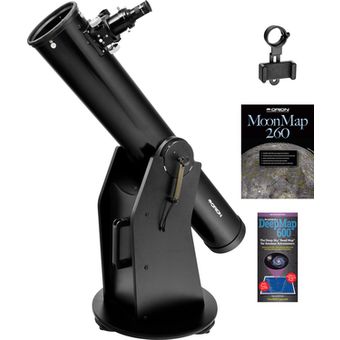
Image Credit: Orion (Used with Permission)
The Orion SkyQuest XT6 Dobsonian arguably provides one of the best reflector telescopes for beginners… so long as you’re not concerned with portability. If you’re looking for a more permanent scope that you can enjoy from the comfort and convenience of your own backyard, you’ll want to get a good all-rounder like the XT6 that’s capable of providing great views of almost anything. It ranks right up with the Zhumell for our top all-around pick as the best telescope for beginners as well as the best telescope for deep space on our list. (We ranked the XT6 second due to it’s slightly higher cost.)
Scorecard – Orion 8944 SkyQuest XT6 Classic Dobsonian Telescope
| Category | Our Verdict | Why? |
|---|---|---|
| Skill Level | Beginner | Suitable for beginners |
| Quality | 4 out of 5 | Great component quality |
| Ease of Use | 4 out of 5 | Requires collimation but overall ease of use is high |
| Power & Clarity | 4 out of 5 | Wide aperture for bright images |
| Control | 4 out of 5 | Easy to use, requires manual tracking |
| Portability | 3 out of 5 | A little heavy, but still portable |
| Accessories | 3 out of 5 | Just the essentials and one eyepiece |
| Overall Value | 4 out of 5 | Great value |
Why We Like It
The XT6 offers a larger aperture with its 150mm (6 inch) primary mirror than the Zhumell. This justifies the higher cost and means it will provide brighter, better image quality. The extra aperture allows more light in to help detect faint galaxies. The longer 1200mm focal length also helps increase magnification for observing planets. Overall, the SkyQuest XT6 offers a fantastic option if you want to see both near and far, making it, in our view, a top contender for best beginner telescope, and certainly the best telescope for viewing planets and galaxies on our list.
At 34 pounds, though, it’s on the heavy side and not really for travelling around. But the convenient carry handle makes it possible to move inside and outside at your house or cabin if the weather turns against you. Having an alt-azimuth Dobsonian mount also means this is both super-easy to set up and use.
Unfortunately, the XT6 only comes with one eyepiece, a 25mm that will produce a magnification of 48x, but with a usable range of 21x to 300x you could use any eyepiece down to 4mm without any problems.
The Orion SkyQuest XT6 is part of the broader SkyQuest series (among our favorite telescopes from Orion) which comes in a range of sizes and options, including upgraded Plus models, IntelliScope, and GoTo packages. One of our favorites from the SkyQuest line is the XT10 (full review here).
Pros
- Good focal length for high magnification
- Aperture makes it the best telescope for deep space on our list
- Easy to set up and use
Cons
- Only one eyepiece is included
- Heavy
3. Celestron NexStar 130SLT – Best Computerized Telescope for Beginners
If you’re relatively new to astronomy, you may not be aware of what to look for in the night sky. A computerized telescope, or “GoTo,” can help with that. Given the necessary nature of the hardware, these types of telescope are more expensive than others, but that doesn’t mean they’re not affordable. With that in mind, the best computerized telescope for beginners is, in our view, the Celestron NexStar 130SLT.
Scorecard – Celestron NexStar 130SLT Computerized Telescope
| Category | Our Verdict | Why? |
|---|---|---|
| Skill Level | Beginner to Intermediate | Advanced computerized capabilities |
| Quality | 5 out of 5 | Great component quality |
| Ease of Use | 5 out of 5 | Automatically locates and tracks objects |
| Power & Clarity | 4 out of 5 | Good aperture, good magnification |
| Control | 4 out of 5 | Computerized mount; Star Locator tech. Scope can be a bit much for the mount. |
| Portability | 4 out of 5 | Light-weight and easy to move |
| Accessories | 3 out of 5 | Basics included but there are a few additional things you'll probably want to add |
| Overall Value | 4 out of 5 | Great value in a go-to scope |
Why We Like It
The great thing about a computerized scope like the NexStar 130SLT is that it can suggest objects for you to view and then automatically find them for you. There’s no need to get lost while trying to hop from star to star, making this a great choice for anyone who doesn’t know Ursa Major from Ursa Minor.
You don’t need any specialized knowledge to set up the NexStar 130SLT either. You simply search for your location, input the current date and time and then point it to two bright stars in the sky. The onboard computer will then identify the stars and you’re ready to go. That ease-of-use makes Celestron computerized telescopes like the 130SLT and the 127SLT some of our favorites for beginners.
With an aperture of 130mm (slightly more than 5 inches), the NexStar 130SLT also provides great visual value for money. It has a focal length of 650mm and comes with two eyepieces. The first, a 25mm, will provide a magnification of 26x while the second, a 9mm, will give you 72x. If you pick up additional eyepieces or a barlow, you could increase the scope’s magnification up to 260x.
In comparison with the Celestron NexStar 127SLT (another top pick & beginner favorite for planetary viewing which we cover here), the 130SLT will give you a wider field of view for viewing deep sky objects. (We’re into that a bit more at the moment, and so went with the 130SLT over the 127SLT today, but both are great.)
If there’s a downside, it’s that the scope requires power, in the form of eight AA batteries. Depending on how frequently you use the scope (and for how long), you could easily drain these batteries quickly. Celestron separately offers an AC adapter as an alternative or, if you’re nowhere near an outlet, power banks.
If you’re looking for something with even more power, we also like the NexStar SE series (which we also cover here), especially the NexStar 8SE (full review here).
Pros
- Computerized scope can find your target for you
- Built-in database containing thousands of objects
- Easy to set up and use
Cons
- AC adapter may be necessary
4. Celestron Astromaster 70AZ Refractor Telescope – Best Refractor Telescope for Beginners (Also Good on a Tight Budget)
Our pick for best refractor telescope for beginners also comes at a great price point. The Astromaster 70AZ from Celestron is a ready-for-anything refractor telescope. Even if you’ve never used a telescope before, you’ll be navigating the night sky in minutes with this telescope.
Scorecard – Celestron Astromaster 70AZ
| Category | Our Verdict | Why? |
|---|---|---|
| Skill Level | Beginner | Easy to get started |
| Quality | 4 out of 5 | Great component quality |
| Ease of Use | 4 out of 5 | Setup in minutes |
| Power & Clarity | 3 out of 5 | Average |
| Control | 3 out of 5 | Average, AZ mount |
| Portability | 4 out of 5 | Light-weight and easy to move |
| Accessories | 3 out of 5 | Everything needed plus two eyepieces |
| Overall Value | 4 out of 5 | Great value |
Why We Like It
The Astromaster 70AZ comes with all the accessories you need to get started, including two eyepieces (10mm and 20mm), a travel tripod (steel, full-height adjustable), an image star diagonal, and a red dot finder scope. The sleek refractor design is super easy and fast to setup and use, and it doesn’t require collimation, which makes it great for beginners!
With an aperture of 70mm and magnification of 45x to 90x, it’s not the highest-powered telescope around, but it’s very affordable. In any case, at this power / magnification level, you can still get bright and clear images of objects like Jupiter, Orion Nebula, the Moon, Mars, and Saturn. Or, you can use the 70AZ for viewing objects and landscapes in the daytime.
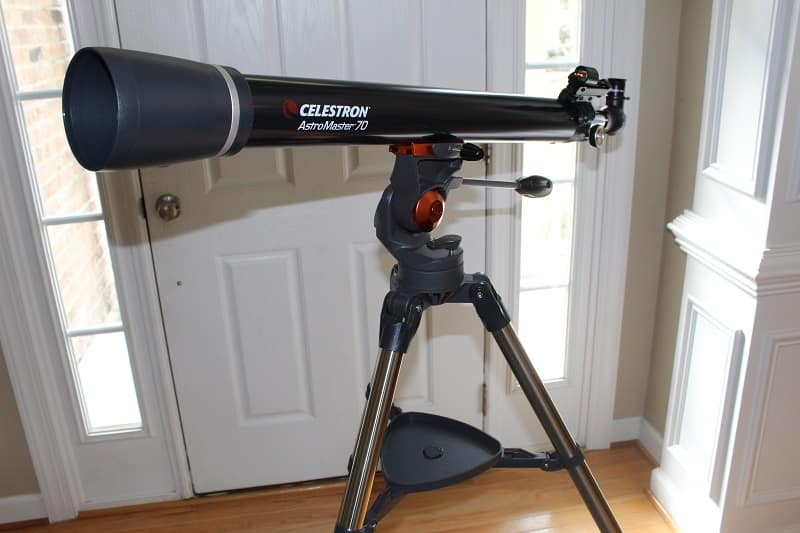
Image Credit: Brian Taylor / TelescopeGuide.org
Additionally, the Astromaster 70AZ telescope comes with durable, professional, high-quality components and materials. It’s engineered with fully-coated all-glass optics, a lightweight frame, and a manual Alt-Azimuth mount. Finally – and for many people, this is important – it weighs just 11 lbs. which makes it ultra-portable and easy to take with you on the go.
If you want a little more light-gathering capability in a refracting telescope (and you’re willing to spend a little more money), we also like the Orion AstroView 90mm (which you can read more about here).
Pros
- A great telescope for beginners
- Everything you need to get started
- Super lightweight and portable, weighing just 11 lbs.
- Budget-friendly
- Easy to control & use
Cons
- The tripod is not the best – some users have reported stability problems
- Lower magnification and smaller aperture for light collection
5. Celestron ExploraScope 114AZ – Best Reflector Telescope for Beginners on a Moderate Budget
If you’re looking to spend a little less than our first 2-3 options, the Celestron ExploraScope 114AZ is our pick for the best telescope for beginners on a moderate budget. While pricing varies, it’s often around 25% less than our top pick.
Scorecard – Celestron ExploraScope 114AZ Telescope
| Category | Our Verdict | Why? |
|---|---|---|
| Skill Level | Beginner | Suitable for beginners |
| Quality | 3 out of 5 | Entry-level reflector option |
| Ease of Use | 3 out of 5 | Bird-Jones style can be difficult to collimate |
| Power & Clarity | 3 out of 5 | Good aperture size for the price point |
| Control | 3.5 out of 5 | Easy to use alt-azimuth mount with slow-motion controls |
| Portability | 4 out of 5 | Compact and easy to move |
| Accessories | 3.5 out of 5 | Everything needed plus two eyepieces and a 3x Barlow lens |
| Overall Value | 4 out of 5 | Good value; spherical mirror (vs. parabolic) keeps the cost down |
Why We Like It
This ExploraScope reflector sports a primary mirror of 114mm, or 4.5 inches, which is more than enough for a beginner to start to explore the Moon, Jupiter’s moons, Saturn’s rings, the Orion Nebula and other celestial objects.
It also comes with a good set of accessories, including a traditional tripod and alt-azimuth mount. The tripod itself can adjust to suit your height and includes an accessory tray to hold your eyepieces. The alt-azimuth mount makes it easy to use, and there’s an attached slow motion rod control for more precise positioning.
The scope also comes with two eyepieces – a 20mm and a 4mm – and a 3x barlow lens. The telescope has a focal length of 1000mm, and the eyepieces will produce a magnification of 50x and 250x, respectively. Generally, higher magnifications help with observing planets, while lower magnifications are better for larger objects, such as star clusters.
The 3x barlow seems meant more for the 20mm eyepiece, which will give you 150x. (Most of the magnification from applying the 3x barlow to the 4mm won’t be usable – the scope maxes out usefulness around 269x.) In any case, a barlow is a very useful accessory that’s not usually supplied with the scope, and you can always buy more eyepieces to get a range of magnifications. For example, buying a 12mm eyepiece will give you a magnification of 83x or 249x with the barlow.
Lastly, with a total weight of just 6.7 pounds, you shouldn’t have any problems being able to pack this up and move it to the backyard or drive it out to your favorite IDA Dark Sky Park.
Pros
- Long focal length for higher magnifications
- Great accessories
- Great value for money
Cons
- A 4mm eyepiece can be a little uncomfortable for some
- Watch out for the Bird-Jones style reflector design – while this allows for a compact and affordable design, these are tricky to collimate and you’ll need to invest the time to learn to do it properly. This is the biggest tradeoff in order to get such an affordable reflector.
6. Orion Starblast 4.5 Astro Reflector – Best Telescope for Home Use
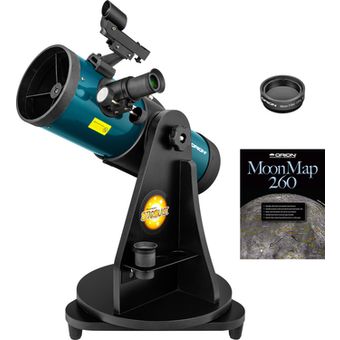
Image Credit: Orion (Used with Permission)
If you and your family are just beginning astronomy and looking for the best telescope for home use, you’ll find few better options than the Orion StarBlast 4.5 Astro Reflector. A number of features, and the included extras in the MAX KIT, make this a great choice for using with the family around the house.
Scorecard – Orion StarBlast 4.5 Astro Tabletop Reflector
| Category | Our Verdict | Why? |
|---|---|---|
| Skill Level | Beginner | Suitable for beginners |
| Quality | 4 out of 5 | Great component quality |
| Ease of Use | 4 out of 5 | Easy to use tabletop design; requires collimation |
| Power & Clarity | 3 out of 5 | Bright images but not for high magnification |
| Control | 3 out of 5 | Tabletop AZ mount |
| Portability | 4 out of 5 | Super compact and easy to setup, weighs 13 lbs. |
| Accessories | 3 out of 5 | Everything needed to get started |
| Overall Value | 4 out of 5 | Great value |
Why We Like It
Firstly, the Orion StarBlast 4.5 provides an affordable price point for many families looking for the best telescope for home use.
If you’re willing to spend a little more on upgrades, Orion offers the Starblast 4.5 bundled with a MAX KIT that includes the Moon Map 260, moon filter, Star Target Planisphere, a 2x Barlow lens, a Telescope Observer’s Guide, and a RedBeam flashlight. (MAX Kit: See it on Telescope.com or See it on Amazon.com.) This provides a great-value starter kit for new beginners.
Secondly, the StarBlast is relatively compact and easy-to-use. At 13 pounds, you or your family members can move it from one location to another around the home with ease. It arrives pre-assembled too, so you can take it outside and start enjoying it immediately.
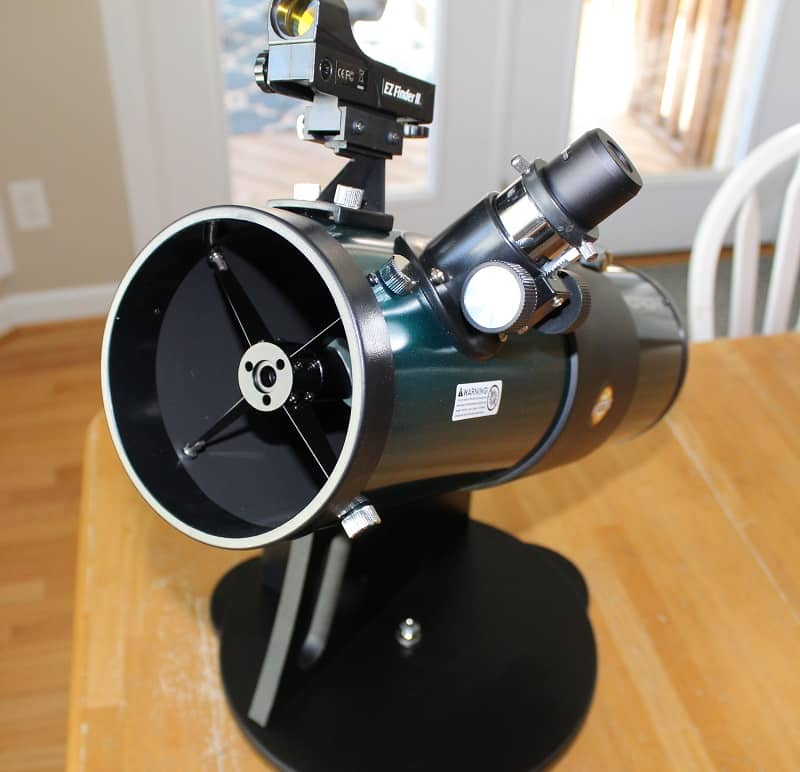
Image Credit: Brian Taylor / TelescopeGuide.org
With a compact, tabletop form, you can either place it on the ground so the smaller children get a good view, or place it on a table and allow the adults to get a closer look. We rated the versatile table top form factor highly when selecting this as one of the best telescopes for home use at a beginner price point.
Thirdly, despite its small size, the StarBlast 4.5 Astro Reflector packs a punch. The 114mm (4.5 inches) aperture has allows enough light to provide outstanding views of the Moon, planets, star clusters, nebulae and galaxies.
While the focal length is a little on the short side (450mm), the two eyepieces supplied with the scope will suffice to get you started. The 17mm eyepiece provides magnification of 26x, which works great for the Moon and larger star clusters and nebulae. The 6mm eyepiece will magnify the view 75x – enough for views of the Moon close-up, as well as the rings of Saturn, colorful double stars and smaller star clusters.
Pros
- Budget friendly
- Pre-assembled and instantly usable
- Compact and portable
Cons
- Short focal length resulting in low magnifications
7. Orion FunScope 76mm – Best Telescope for Children
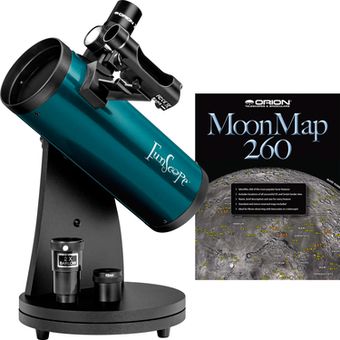
Image Credit: Orion (Used with Permission)
Got a young child who’s a budding astronomer? Maybe you want to encourage their interest but don’t want to spend too much in case the spark fizzles out? Orion’s Funscope provides one of the best telescopes for beginners under $100 and one of the most appropriate for children.
Scorecard – Orion FunScope 76mm TableTop Reflector
| Category | Our Verdict | Why? |
|---|---|---|
| Skill Level | Beginner | Easy to get started |
| Quality | 3 out of 5 | Good quality build and design for price |
| Ease of Use | 4 out of 5 | Simple, and easy to use |
| Power & Clarity | 3 out of 5 | Not a high-powered, but good for price point; wide views |
| Control | 3 out of 5 | Average, AZ mount |
| Portability | 5 out of 5 | Lightweight tabletop design |
| Accessories | 3 out of 5 | Comes with Moon Map |
| Overall Value | 4 out of 5 | Great option for kids |
Why We Like It
The FunScope provides a small, lightweight and very portable option that’s ideal for kids under the age of ten.
Depending on your budget, Orion offers three options for you. You could either go for the scope and Moon map bundle or a bundle that includes the scope, Moon map, lunar filter and a book highlighting the sights you can see. Lastly, for younger kids, there’s the Kids Kit, which has the most items and provides the best value for money. It includes the scope, Moon Map, lunar filter, planisphere and a book for young stargazers called Exploring the Cosmos.
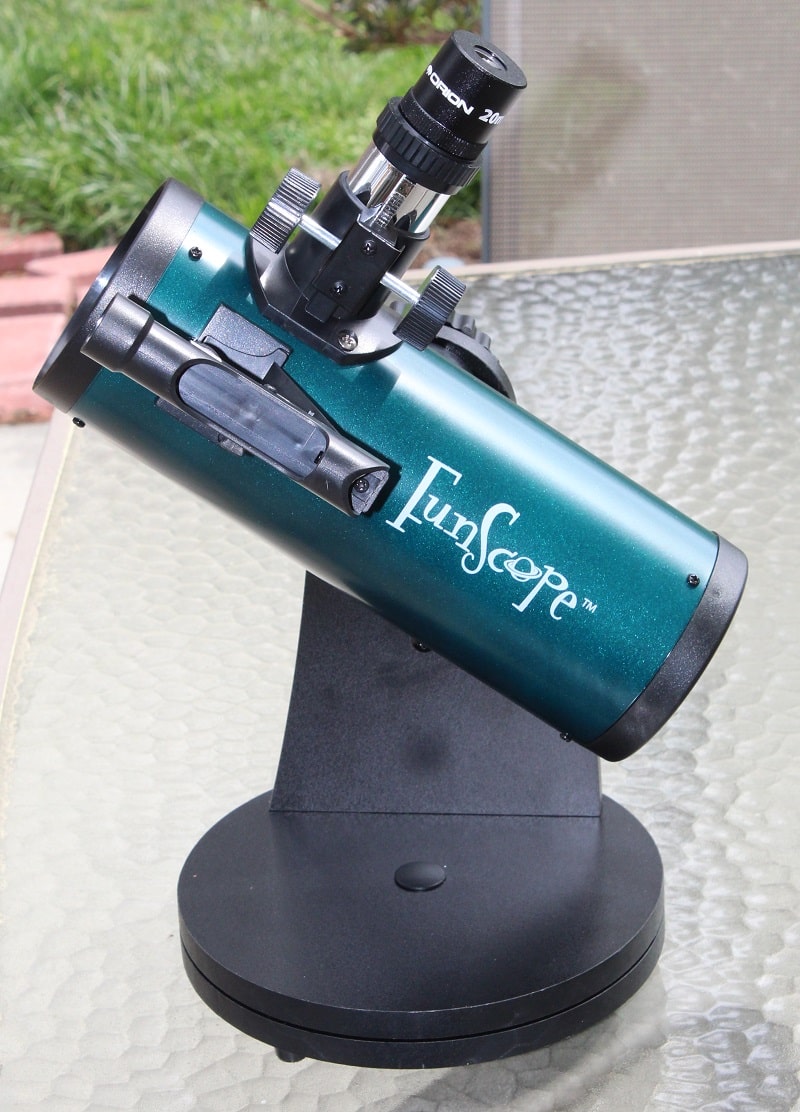
Image Credit: Brian Taylor / TelescopeGuide.org
Regardless of the package you go for, Orion supplies two eyepieces – a 20mm and a 6mm. The FunScope’s focal length reaches 300mm, producing a magnification of 15x from the 20mm and 50x for the 6mm lenses. This might not seem like a lot, but it’s plenty for many double stars, star clusters, nebulae, Jupiter and Saturn and, of course, the Moon.
(Incidentally, if you buy one of the bundles, you’ll definitely want to use a lunar filter. Without it, moonlight can be dazzling and leave you seeing the wrong kind of stars in your eyes!)
Like the Orion StarBlast, the FunScope comes pre-assembled, allowing you (or your kids!) to take it out of the box and immediately start using it. Weighing in at just four pounds, this scope is super light, making it easy for you or your children to move. It’s also very compact. You can place it on a table outside or even taken camping with you.
Pros
- Lightweight and easy-to-use; good for younger children
- Budget friendly
- Pre-assembled and instantly usable
Cons
- Short focal length resulting in lower magnification; limited use beyond observing the Moon
8. Celestron StarSense Explorer LT 114AZ – Best Telescope for Teenagers
The Celestron StarSense Explorer LT 114AZ provides one of the best telescopes for beginners if you’re buying for older kids or teenagers, perhaps over the age of 12 or so. The good aperture combined with its software and mobile phone interaction make it a great find for tech-savvy teens.
Scorecard – Celestron StarSense Explorer LT 114AZ Telescope
| Category | Our Verdict | Why? |
|---|---|---|
| Skill Level | Beginner | Smartphone navigation, easy for beginners |
| Quality | 3 out of 5 | Entry-level reflector option |
| Ease of Use | 3.5 out of 5 | The smartphone technology makes it easy to use; but the Bird-Jones style can be difficult to collimate |
| Power & Clarity | 3 out of 5 | Good aperture size for the price point |
| Control | 4 out of 5 | Dual axis slow motion control (alt-az) |
| Portability | 4 out of 5 | Compact and easy to move |
| Accessories | 3.5 out of 5 | Everything needed plus two eyepieces and a 2x Barlow lens |
| Overall Value | 4 out of 5 | Great technology experience; spherical mirror (vs. parabolic) keeps the cost down |
Why We Like It
The ExploraScope and StarSense Explorer have some similarities. For instance, both have an aperture of 114mm or 4.5 inches and a focal length of 1000mm (more powerful than, say, the FunScope that we’d recommend for younger kids). Also, like the ExplorScope, the Celestron StarSense Explorer has an accessory tray for your eyepieces, an attached slow motion rod control for precise positioning and comes with two eyepieces and a Barlow. They differ, however, in a couple of small ways and one more important way.
Firstly, the Celestron StarSense Explorer comes with different variants of eyepieces and Barlow lens. With the StarSense, you’ll get a 25mm and 10mm eyepiece that provide magnifications of 40x and 100x, respectively. Secondly, the StarSense also has a 2x Barlow lens versus the 3x with the ExploraScope. The combination provides the StarSense Explorer with 80x and 200x magnification – great for observing the planets and well within the scope’s theoretical limit of 269x.
Additionally, the StarSense comes with a mount for your cell phone – a really cool feature for older kids and teenagers that differentiates it from the ExploraScope. By installing the StarSense app, you can follow the on-screen arrows and guide your scope to a selected target in the night sky. Once the bullseye turns green, you should have your target visible in your eyepiece. More than this, the app can also suggest objects for you to view, so you won’t be left wondering what you should see or get bored looking at the same targets every night! We rated StarSense Explorer as one of the best telescopes for teenagers on this list for the mobile phone interaction and software support.
Finally, the telescope comes with a good set of accessories to get you started, including tripod, finderscope, lenses and more. This provides a great option to get older kids and families out of the house and exploring the night sky.
Pros
- StarSense app to guide you to the best objects
- Great accessories and phone mount
- Long focal length resulting in higher magnifications
Cons
- Not really suitable for younger children
- Watch out for the Bird-Jones style reflector design – while this allows for a compact and affordable design, these are tricky to collimate and you’ll need to invest the time to learn to do it properly. This is the biggest tradeoff in order to get such an affordable telescope with this set of features.
9. Orion GoScope III 70mm Refractor – Best Telescope for Travel (Option 1)
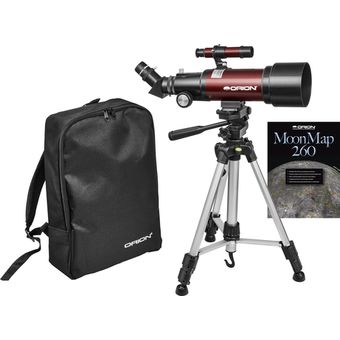
Image Credit: Orion (Used with Permission)
You won’t find the best Dark Sky sites near the lights of any town or city. If you’re into camping, you’ve probably already seen how fantastic the stars can be from your favorite campground. What’s the best beginner scope for travel and camping? Take a look at the Orion GoScope III, an easy-to-use 70mm alt-azimuth refractor that’s been designed for exactly that.
Scorecard – Orion GoScope III 70mm Refractor Travel Telescope
| Category | Our Verdict | Why? |
|---|---|---|
| Skill Level | Beginner | Easy to get started |
| Quality | 3 out of 5 | Decent quality build for price |
| Ease of Use | 3 out of 5 | Simple to use |
| Power & Clarity | 3 out of 5 | Not a high-powered, but fine for price point |
| Control | 2 out of 5 | AZ mount is not the best |
| Portability | 4 out of 5 | Lightweight and portable |
| Accessories | 4 out of 5 | Comes with lenses, tripod, pack and Moon Map |
| Overall Value | 3 out of 5 | Solid option for kid or beginner travel scope |
Why We Like It
Primarily, the GoScope III comes with a good set of travel accessories that you can easily port around. For example, it comes with its own backpack that can carry both the telescope and the collapsing tripod. Even fully loaded, the backpack only weighs slightly more than four pounds, making it super lightweight and easy to carry.
The backpack can also carry the eyepieces supplied with the scope. The telescope comes with two, a 20mm and 9mm, that will produce magnifications of 20x and 44x respectively. The focal length of the scope itself is 400mm, on the shorter side, but we’re compromising for portability here.
As with the FunScope, Orion offers three bundles, offering outstanding value for money. Two of the bundles include books and a planisphere to get you started while all three have a lunar map to help you identify the craters and features on the Moon.
Besides the Moon, you’ll find this scope capable of showing you the cloud belts of Jupiter, the rings of Saturn and the phases of Venus, but obviously not as clearly as some of the other options on this list. Outside the solar system, you’ll find yourself exploring all kinds of star clusters, nebulae, multiple stars and even spotting the occasional galaxy or two.
Pros
- Budget friendly
- Easy to use
- Very portable
Cons
- Lower image quality than others
10. Celestron 70mm Portable Refractor Telescope – Best Telescope for Travel (Option 2)
In our opinion, one of the best travel telescopes at a great price point. You’ll love this ultra-portable telescope that has everything you need for viewing on the go. Celestron’s 70mm travel scope is one of the most popular telescopes on the internet and for good reason. (For more on this one, see our full review here.)
Scorecard – Celestron 70mm Travel Scope
| Category | Our Verdict | Why? |
|---|---|---|
| Skill Level | Beginner | For beginners of all ages |
| Quality | 4 out of 5 | Good optics, but let down by the accessories |
| Ease of Use | 4 out of 5 | Generally very easy, but needs a better finder and tripod |
| Power & Clarity | 3 out of 5 | Limited to about 100x in magnification |
| Control | 4 out of 5 | Generally very easy, but the tripod hampered |
| Portability | 5 out of 5 | Super light, ideal for camping and hiking |
| Accessories | 2 out of 5 | The eyepieces aren't terrible, but generally everything needs to be replaced |
| Overall Value | 4 out of 5 | Good for the price, but you'll need to pay more for decent accessories |
Why We Like It
The top reason to buy this 70mm Celestron travel telescope is for portability. Weighing in at 3.3 lbs. (seriously!), the telescope and all its accessories (even the tripod) packs easily into a custom canvas backpack so you can take it anywhere. It’s easily one of the most versatile telescopes for traveling, hiking, camping, and many other activities where you need a light, compact, easy-to-setup telescope that you can pack up and and carry just about anywhere.
Additionally, it comes with a good set of starter accessories, including two eyepieces (20mm and 10mm), an erect image star diagonal, a finder scope, full-height adjustable tripod, and of course the traveling backpack. Additionally, the mount is Alt-Azimuth, which is ideal for a traveling scope.
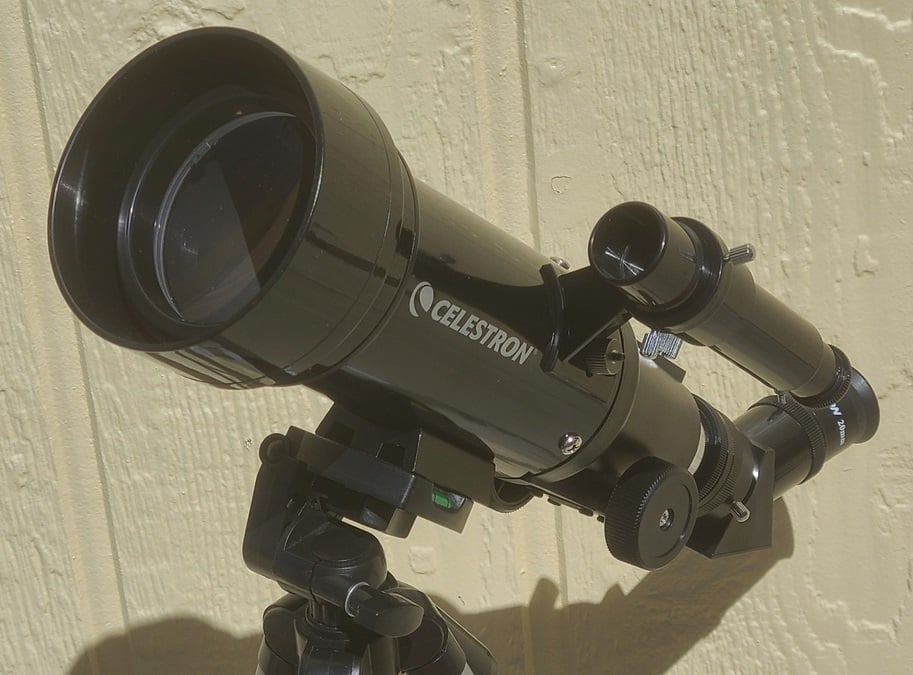
Image Credit: Richard Bartlett / TelescopeGuide.org
With its all-glass optics and 70mm aperture, it packs plenty of light collection and magnification ability for the beginner, and the refractor design makes it simple and easy to use. It’s not the highest-powered telescope in the world, with magnification of 20x to 40x using the included eyepieces – but that’s plenty for viewing the moon, other solar system objects, planets, and star clusters. Plus, with the star diagonal you can use it as a spotting telescope in the daylight. (So, if you’re hiking, you can use this telescope anytime – you can admire nature and wildlife during the day, then stargaze at night!) The optics are fully-coated glass and the telescope is backed by Celestron’s two-year warranty, so you can buy with confidence in Celestron’s quality and support.
If you have a little more money to spend, you might consider the 80mm instead. It’s slightly larger aperture allows you to see fainter objects, and it also includes a smartphone mount! Overall, though, this is an incredibly popular telescope because it’s hard to beat the value offered.
Pros
- Designed for “on the go” viewing
- Ultra-portable and ultra-lightweight at just 3.3 lbs.
- All the accessories you need including tripod and travel backpack
Cons
- Not for high-powered viewing
- Does not include the smartphone mount like the 80mm Celestron travel scope
Part 2 | Telescope Buyer’s Guide: Selecting the Best Telescope for Beginners in 2022
So, we’ve set out some of the best telescope for beginners above. What else should you consider before you buy your first telescope? The following should give beginners a good sense of the key things to consider when buying your first telescope.
What to Consider About Yourself (or the Recipient) Before Buying?
Interest in astronomy?
Firstly, you or the person you’re buying for needs to think about whether they’re ready for a telescope. Generally speaking, it’s best to familiarize yourself with the night sky and understand the types of celestial objects you can see. Not only will this knowledge help you to find your targets, but it will also give you a realistic expectation of how they might appear.
It’s important to keep in mind that many of the objects you see won’t appear the same as they do in books and magazines. Those images take painstaking work on the part of the photographer, who heavily processes them to produce the best results. Our eyes aren’t sensitive to color like a camera, so we won’t usually see the blues, reds and greens apparent in photographs. (Multiple stars differ a bit, and some wonderful colored pairs are worth seeking out.)
What type of telescope user?
Secondly, you should also consider who’ll primarily use the telescope and what method of observation they’ll be using. Manufacturers design different telescopes with different groups in mind, and trade-offs exist.
For example, will the telescope operator be you, a younger child, teenager, the family as a whole, etc.? That may impact the quality, price and functionality that you look for.
Will the telescope user want to try out astrophotography? If so, you may need a higher quality telescope or at least the ability to capture quality images with the help of a camera or mobile phone mount.
Knowing who’ll use the telescope and how will help you pick the features that you need.
What do you want to see?
Thirdly, think about what you’d like to see. (And be sure to check out our favorite things to see with a telescope.) Again, the different features of the telescopes allow different possibilities, and trade-offs exist.
Obviously, there’s the Moon and planets, and while almost every telescope can observe the Moon, some telescopes have features better suited to observing the planets. For example, you’ll need one that’s capable of producing good quality views at a higher magnification, perhaps with a narrower field of view, to be able to truly enjoy observing Mars.
Beyond our own solar system, you can literally find thousands of “deep sky” objects. You can also see many double, or even multiple, stars – i.e., stars that appear to be a single star to the naked eye, but when you turn a telescope toward it, you actually find two (or more) stars visible. Perhaps the most famous example of a double star is Albireo, in the constellation of Cygnus. A low magnification of about 35x is enough to show two stars – one gold, one sapphire blue.
You can also view star clusters, which come in two varieties. An open star cluster is a group of hundreds or even thousands of stars that are packed together into a relatively small space. The Pleiades star cluster in Taurus and the Beehive cluster in Cancer are both fine examples.
The other type of star cluster is a globular star cluster. These contain hundreds of thousands of stars that are gravitationally bound together so they form a huge sphere in space. One of the best examples in the northern hemisphere is M13, the Keystone Cluster in the constellation Hercules.
You can also see nebulae, which are huge clouds of gas and dust in space where the stars themselves are born. At the other end of the stellar lifespan, planetary nebulae are the shells of gas thrown off by dying stars. And of course, the night sky offers literally hundreds of distant galaxies to be seen. These typically faint objects require telescopes with higher aperture and wider fields of view to bring in more light.
Where will you be observing from?
Fourthly, you should think about the locations where you’ll want to use the telescope and how must portability / ease-of-set-up you’ll be needing for that.
Dobsonian telescopes offer some the best image quality for the price but are also some of the least portable options, for instance. They would work well for people who will park their telescope at a cabin or their house, and move it less frequently. A Dobsonian probably wouldn’t be the right pick for someone who wants to carry a telescope with them as they hike through the mountains or go camping or needs to move it around a lot. In that case, you’d want something light weight and easy to set up.
Another consideration is whether you will typically have more or less light pollution or other factors affecting visibility. Computerized, GoTo telescopes can help a lot closer to cities where it’s harder to find objects and/or get orientated with the naked.
What’s your budget?
Last but not least, price matters for everyone. You get what you pay for with a telescope, so we wouldn’t recommend going unnecessarily cheap. But, as a beginner, you probably don’t want to drop thousands on the top quality telescopes and astrophotography rigs in one go. All of the recommendations above have been made with cost in mind and keep the pricing under $500 as of the date of the initial publication of this article.
Getting familiar before you make an investment
Before you invest in a telescope for yourself, you might consider ways to participate in astronomy without purchasing your own equipment.
1. Join a local astronomy club and attend one of their “star parties”. The astronomy community is a friendly bunch, and people love to share tips with each other and showcase their equipment.
2. Some telescope owners actually share their telescopes and imagery with others online through a service called “remote astronomy.” (You could check out slooh.com which is an online astronomy community with a variety of remote telescopes available to its members. If you’re interested in astrophotography, check out our article on getting started with astrophotography using remote telescopes.)
3. Virtual astronomy: Other websites offer classes and educational materials where you can learn about the night sky through virtual astronomy. These offer a great way to get a taste of what’s out there and see if it sparks your interest. One such organization is “Look Up to the Stars”. If you are looking for a virtual astronomy class, camp or program, then be sure to check them out here.
What to Know About Telescopes Before Buying?
When amateur astronomers talk about a smaller or larger scope, they’re talking about the telescope’s “aperture”. This is the diameter, usually measured in millimeters, of its lens or mirror (more about that in a moment.) The larger the aperture, the more light it is able to gather. The more light it can gather, the fainter the object it can detect and the more detail you’ll be able to see. You’ll therefore need a larger aperture to see the fainter objects, such as galaxies.
You’ll also need to know the focal length of your equipment. This is the distance that light must travel from where it enters the equipment to where it exits. For a telescope, the entry point is the end that points up at the sky, while the exit point is the focuser that holds the eyepiece. Eyepieces themselves also have focal lengths.
Knowing the focal length of your telescope and eyepieces is important because you can use these numbers to calculate the magnification you’re using. To do this, simply divide the focal length of the telescope by the focal length of the eyepiece. For example, if you have a telescope with a 500mm focal length and an eyepiece with a focal length of 10mm, your magnification is 50x.
A Barlow lens is an adapter that can multiply the magnification of any eyepiece you use with it. For example, if you had a 2x Barlow and used it with the telescope and eyepiece in the example above, you’d get a magnification of 100x. A Barlow is an essential accessory because it will immediately double the number of magnifications you have available.
Incidentally, if you want to observe the planets, it’s best to use a higher magnification. With the exception of Jupiter and Saturn, the planets typically appear small and it can be difficult to discern any details without a magnification of 150x or higher. That being the case, you’ll want a telescope with a longer focal length and at least a 2x Barlow.
That being said, it’s also important to remember that magnification has useful limits. A common rule of thumb in the amateur astronomer community is that a telescope’s useable magnification will cap out at around two times the aperture of a telescope in millimeters. (For example, Celestron says the ExploraScope mentioned above has a maximum magnification of 269x… about 10% over the rule of thumb… and why we point out that the Barlow lens included in the package only works with one of the eyepieces.)
We generally recommend focusing much more on aperture (i.e., lens or mirror diameter) than magnification.
What Are the Different Types of Telescope?
The best telescope for beginners typically comes in one of two main forms: refractors or reflectors. We discuss the differences between these two types in detail in another article here. To summarize quickly:
1. A refractor is what many people would consider to be a traditional telescope. The light enters through a lens, travels down the optical tube and then exits through the eyepiece at the bottom. Refractors don’t need much maintenance. They can, however, be more cumbersome and limited in terms of their aperture. They also suffer from chromatic aberration, though methods exist these days to mitigate its effects.
2. A reflector (Newtonian reflectors being a common type for beginners) uses mirrors to bounce the light to the eyepiece. Light enters the telescope through the open end that points up at the sky. The light then travels down the optical tube to a large, primary mirror at the bottom. The mirror reflects the light back to a secondary mirror, and then out of the tube at an angle. Since the mirrors bounce the light back and forth, you get good focal length without needing a long tube. This means you can get a larger telescope with a longer focal length that’s still compact and portable. The downside to a reflector is that you have to fine-tune the alignment of the mirrors (i.e., collimation).
3. A third type of telescope, called a catadioptric (including Cassegrain, Schmidt-Cassegrain or Maksutov-Cassegrain), uses both lenses and mirrors. Catadioptrics pack high focal length and aperture into a compact package, but can cost more than other types. They have been slowly gaining in popularity (and are some of our top rated telescopes). But the vast majority of beginner scopes will still be either refractors or reflectors.
What Are the Different Types of Telescope Mount?
Besides the types of telescope, you will want to consider the type of mount that comes with your telescope. This will help you determine if its suitable for beginners. Here, too, we have two main types:
First, the alt-azimuth mount is the oldest and simplest. It allows the scope to move horizontally and vertically in a straight line. It’s easy enough for anyone, at any age or level of experience, to use.
Second, an equatorial mount essentially tilts the telescope at an angle that matches your target’s path across the sky. This makes it easier to track your target (necessary for astrophotography), but can often be tricky to set up and a little confusing for a beginner to use. For that reason, we recommend beginners choose a telescope with an alt-azimuth mount. All of our selections reflect this.
Lastly, note that not all telescopes use a tripod. While refractors do, it’s not necessarily the case for reflectors. In recent years, the Dobsonian mount has grown in popularity and is now one of the most common mounts available. It’s a simple alt-azimuth mount where the optical tube is held between two prongs, like a fork. The fork then sits on a flat base. While the fork allows the scope to move vertically, the base turns to allow the scope to move horizontally. Although Dobsonians can be used with a range of reflectors, they’re specifically designed for much larger, less portable telescopes.
Final Thoughts
Whew! If you’ve made it this far, you’re prepared to select your favorite from among the best telescopes for beginners. While there is no single right answer for everyone – we hope this article gave you some good places to start. There’s a perfect telescope for your needs, your budget, what you want to see, and where you want to go with your telescope.
(Also, if you liked this article, please share it using the social media buttons below!)About the Author
Richard J. Bartlett: Richard has been featured in Sky & Telescope and Astronomy magazine. He’s written and published a number of astronomy-related books, and we’re super happy to be able to work with him on Telescope Guide articles.Why You Can Trust Our Reviews
At TelescopeGuide.org we're as passionate about astronomy as you are. As such, we take our recommendations seriously and would never recommend anything we wouldn't be willing to buy and use ourselves. When we consider our recommendations, we look at a wide variety of products from a range of manufacturers. We take into account the quality of the product, as well as its durability, ease-of-use, performance, and overall value for money.Whenever we can, we test the products ourselves or, if that's not possible, we consider the opinions and experiences of other astronomers. Lastly, we take all these criteria and make our decision by creating an objective score for each one. In this way, whatever your needs, requirements or budget, you can be sure you're getting the best possible advice before you make your buying decision.
Feature Image Credit: stevecoleimages / iStock







